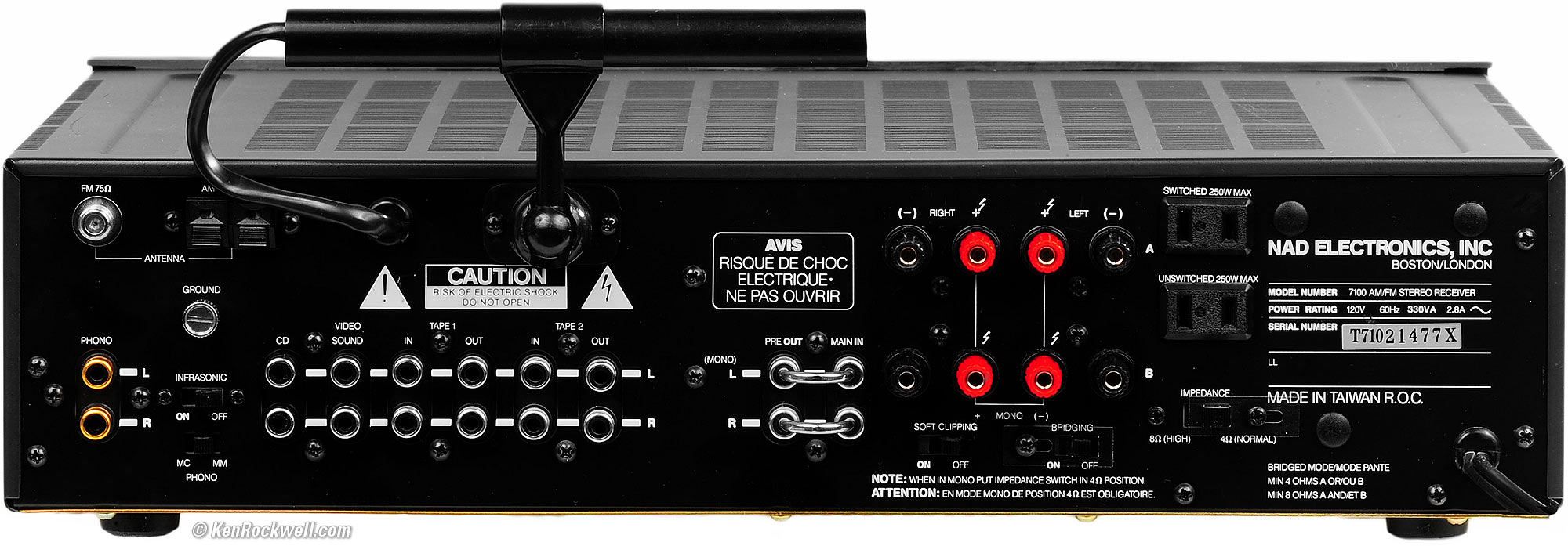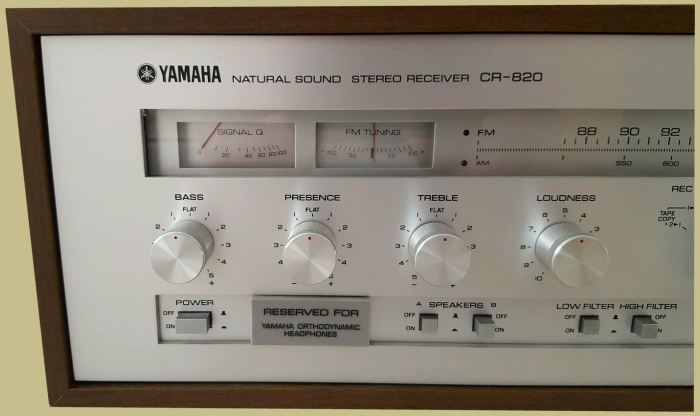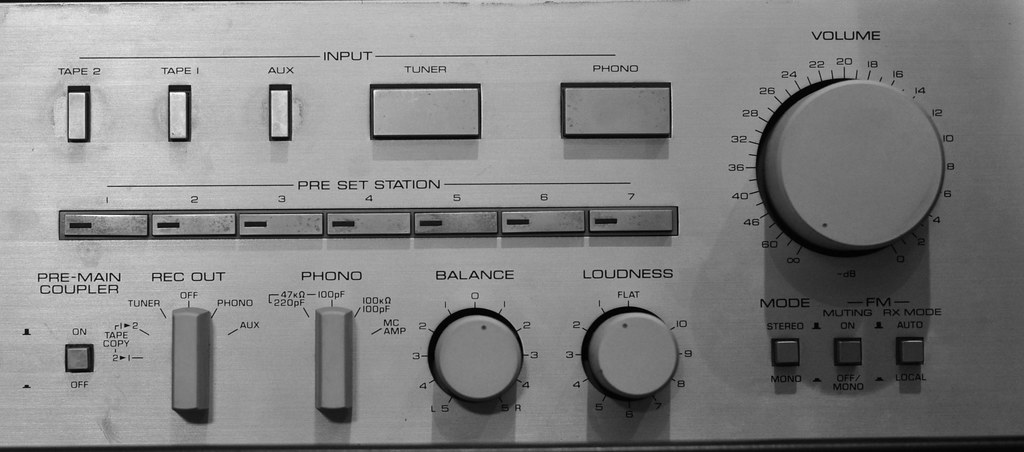Your Stereo receiver loudness button images are ready in this website. Stereo receiver loudness button are a topic that is being searched for and liked by netizens now. You can Get the Stereo receiver loudness button files here. Get all free photos.
If you’re searching for stereo receiver loudness button pictures information related to the stereo receiver loudness button keyword, you have come to the right site. Our website frequently gives you suggestions for downloading the maximum quality video and picture content, please kindly surf and find more informative video content and images that fit your interests.
Stereo Receiver Loudness Button. When you turn the volume up youll want to turn the loudness button off otherwise youll get a very low and high heavy sound when listening louder. It sounds fairly transparent down to about 34 of a turn then just loses everything really. At low SPLs we perceive the loudness of both low frequencies and high frequencies less than we do at higher SPLs. If you want to listen at a lower volume you turn the loudness knob not the volume knob.
 Do You Ever Use The Loudness Control On Your Reciever Ars Technica Openforum From arstechnica.com
Do You Ever Use The Loudness Control On Your Reciever Ars Technica Openforum From arstechnica.com
Met de Loudness functie wordt deze afwijking gecompenseerd en hoor je bij lage volumes ook nog de lage en hoge tonen duidelijk. What the loudness button does is boost the lows and highs just like Mayzei says. Met de loudness uit wordt het volume van de bass mid en treble allen iets gedempt. Then you advanced the loudness control until the marks on the volume and loudness controls were aligned left it there and backed off the volume. By experimenting with the BYPASS button I can confirm that loudness at FLAT and BASS and TREBLE at FLAT is the same as BYPASS being on. Compensate for loss of bass at low listening levels in less efficient speakers being the leading reason that I recall.
The purpose of the loudness button is because the frequency response of our ears isnt the same at low listening levels as it is at higher listening levels Google equal loudness curves.
Compensate for loss of bass at low listening levels in less efficient speakers being the leading reason that I recall. The loudness button or more accurately Loudness compensation button was included to make up for the human ears lack of sensitivity at low SPL not for anything to do with speaker design. When you turn the volume up youll want to turn the loudness button off otherwise youll get a very low and high heavy sound when listening louder. Because this was user selectable it was ok and it actually has a basis in acoustics and one well discuss in this post. Specifically Id like to know if Onkyo or other similar receivers nowdays can easilysimply operate as a stereo receiver. In the 50s when this was first used speaker design was hardly at the current level and what was measured was next to nothing compared with today.
 Source: kenrockwell.com
Source: kenrockwell.com
At lower levels we are less sensitive to lower frequencies and higher frequencies compared to mid frequencies where our ears are most sensitive. Posted September 28 2010. De regelbare Loudness op de versterker is dus eigenlijk een volumeknop waarbij we hoge en lage tonen beter horen. At low SPLs we perceive the loudness of both low frequencies and high frequencies less than we do at higher SPLs. Onze oren zijn het meest gevoelig voor middentonen in het spraakgebied.
Source: avforums.com
Allows you to turn the volume down while boosting some ranges flexibly to make it sound better as the volume lowers. In practice as you all know the loudness contour goosed the low frequency of the source signal for a variety of possible reasons. By the late 80s I tended to leave it disabled as a purist deriving from my. Specifically Id like to know if Onkyo or other similar receivers nowdays can easilysimply operate as a stereo receiver. The loudness button permitted amp designers to add bass and treble boost depending on the volume level listeners chose.
 Source: audiosciencereview.com
Source: audiosciencereview.com
By the late 80s I tended to leave it disabled as a purist deriving from my. What the loudness button does is boost the lows and highs just like Mayzei says. Allows you to turn the volume down while boosting some ranges flexibly to make it sound better as the volume lowers. Its to do with Fletcher-Munson and the ears sensitivity changes at very low playback volume levels. A Loudness switch was supposed to be a compensation for listening at low volumes by boosting the bass and to a lesser extent the treble.
 Source: arstechnica.com
Source: arstechnica.com
Then you advanced the loudness control until the marks on the volume and loudness controls were aligned left it there and backed off the volume. The loudness button or more accurately Loudness compensation button was included to make up for the human ears lack of sensitivity at low SPL not for anything to do with speaker design. AFAIK there was no standard for the amount of compensation so there is no way to estimate when it would engage on your particular receiver. You left the loudness control all the way at the bottom off and moved the volume control to as loud as you would ever listen to music. Compensate for loss of bass at low listening levels in less efficient speakers being the leading reason that I recall.
 Source: forums.stevehoffman.tv
Source: forums.stevehoffman.tv
I find the mix to sound absolutely wonderful on my home stereo much more full and with wonderful low-end. The purpose of the loudness button is because the frequency response of our ears isnt the same at low listening levels as it is at higher listening levels Google equal loudness curves. Specifically Id like to know if Onkyo or other similar receivers nowdays can easilysimply operate as a stereo receiver. So what the loudness control does is what is suggested above. The loudness button or more accurately Loudness compensation button was included to make up for the human ears lack of sensitivity at low SPL not for anything to do with speaker design.
 Source: forums.stevehoffman.tv
Source: forums.stevehoffman.tv
Its to do with Fletcher-Munson and the ears sensitivity changes at very low playback volume levels. In practice as you all know the loudness contour goosed the low frequency of the source signal for a variety of possible reasons. Met de Loudness functie wordt deze afwijking gecompenseerd en hoor je bij lage volumes ook nog de lage en hoge tonen duidelijk. Because this was user selectable it was ok and it actually has a basis in acoustics and one well discuss in this post. AFAIK there was no standard for the amount of compensation so there is no way to estimate when it would engage on your particular receiver.
 Source: audiokarma.org
Source: audiokarma.org
It sounds fairly transparent down to about 34 of a turn then just loses everything really. Normally a 3dB to 6dB boost at 100 Hz. Then you advanced the loudness control until the marks on the volume and loudness controls were aligned left it there and backed off the volume. Id like to drive 4 speakers good and hard and I could care less about 51 surround etc. HelloIve been working on a piece of music lately and I regularly move from my KRK Rokit 5 monitors to a bigger home stereo setup for reference listening.
 Source: audiokarma.org
Source: audiokarma.org
Its to do with Fletcher-Munson and the ears sensitivity changes at very low playback volume levels. Posted September 28 2010. If your receiver has a loudness knob I have a Yamaha that has that feature you use it by having it set at 0 when music is playing at the loudest level you would normally listen at. Compensate for loss of bass at low listening levels in less efficient speakers being the leading reason that I recall. In the 50s when this was first used speaker design was hardly at the current level and what was measured was next to nothing compared with today.
Source: avforums.com
Because this was user selectable it was ok and it actually has a basis in acoustics and one well discuss in this post. I find the mix to sound absolutely wonderful on my home stereo much more full and with wonderful low-end. If you want to listen at a lower volume you turn the loudness knob not the volume knob. That aside those switches never worked that well. Because this was user selectable it was ok and it actually has a basis in acoustics and one well discuss in this post.
Source: reddit.com
Dit houdt dus eigenlijk in dat de loudness niet zorgt voor extra versterking aan deze aan staat maar juist voor extra demping als deze uit staat. The Loudness switch boosts bass response to compensate for the human ears lack of response to those frequencies at low volume levels. Quote from my Trio KA-7100 manual. The purpose of the loudness button is because the frequency response of our ears isnt the same at low listening levels as it is at higher listening levels Google equal loudness curves. The loudness button permitted amp designers to add bass and treble boost depending on the volume level listeners chose.
 Source: audiokarma.org
Source: audiokarma.org
Allows you to turn the volume down while boosting some ranges flexibly to make it sound better as the volume lowers. It sounds fairly transparent down to about 34 of a turn then just loses everything really. What the loudness button does is boost the lows and highs just like Mayzei says. In other words if the loudness contouring control is not enabled at low volume levels bass and treble appear to be lacking. In practice as you all know the loudness contour goosed the low frequency of the source signal for a variety of possible reasons.
Source: avforums.com
Quote from my Trio KA-7100 manual. I find the mix to sound absolutely wonderful on my home stereo much more full and with wonderful low-end. What the loudness button does is boost the lows and highs just like Mayzei says. It reduces midrange frequencies at a greater rate than LF and HF sounds. So what the loudness control does is what is suggested above.
 Source: amazon.com
Source: amazon.com
By experimenting with the BYPASS button I can confirm that loudness at FLAT and BASS and TREBLE at FLAT is the same as BYPASS being on. At lower levels we are less sensitive to lower frequencies and higher frequencies compared to mid frequencies where our ears are most sensitive. Met de loudness uit wordt het volume van de bass mid en treble allen iets gedempt. It sounds fairly transparent down to about 34 of a turn then just loses everything really. AFAIK there was no standard for the amount of compensation so there is no way to estimate when it would engage on your particular receiver.
 Source: reddit.com
Source: reddit.com
Then you advanced the loudness control until the marks on the volume and loudness controls were aligned left it there and backed off the volume. March 30 2018 at 203 am. By the late 80s I tended to leave it disabled as a purist deriving from my. Compensate for loss of bass at low listening levels in less efficient speakers being the leading reason that I recall. Hi Patrick I stand to be corrected but I reckon youll be hard pressed to find someone here who uses a loudness button to attenuate the bass response from their speakers.
Source: europe.yamaha.com
That aside those switches never worked that well. March 30 2018 at 203 am. The loudness control is simply intended to significantly boost low and high frequencies when listening at low levels so that the ear perceives an overall flatter sound pressure level. So what the loudness control does is what is suggested above. If your receiver has a loudness knob I have a Yamaha that has that feature you use it by having it set at 0 when music is playing at the loudest level you would normally listen at.
Source: audiosciencereview.com
That aside those switches never worked that well. Dit houdt dus eigenlijk in dat de loudness niet zorgt voor extra versterking aan deze aan staat maar juist voor extra demping als deze uit staat. It reduces midrange frequencies at a greater rate than LF and HF sounds. Quote from my Trio KA-7100 manual. Its to do with Fletcher-Munson and the ears sensitivity changes at very low playback volume levels.
 Source: dreamstime.com
Source: dreamstime.com
Dit houdt dus eigenlijk in dat de loudness niet zorgt voor extra versterking aan deze aan staat maar juist voor extra demping als deze uit staat. They may use other external devices to EQ the in room response but it wont be the loudness button. If your receiver has a loudness knob I have a Yamaha that has that feature you use it by having it set at 0 when music is playing at the loudest level you would normally listen at. You left the loudness control all the way at the bottom off and moved the volume control to as loud as you would ever listen to music. March 30 2018 at 203 am.
 Source: ebay.com
Source: ebay.com
Dit houdt dus eigenlijk in dat de loudness niet zorgt voor extra versterking aan deze aan staat maar juist voor extra demping als deze uit staat. Well here you are. HelloIve been working on a piece of music lately and I regularly move from my KRK Rokit 5 monitors to a bigger home stereo setup for reference listening. In the 50s when this was first used speaker design was hardly at the current level and what was measured was next to nothing compared with today. Its to do with Fletcher-Munson and the ears sensitivity changes at very low playback volume levels.
This site is an open community for users to submit their favorite wallpapers on the internet, all images or pictures in this website are for personal wallpaper use only, it is stricly prohibited to use this wallpaper for commercial purposes, if you are the author and find this image is shared without your permission, please kindly raise a DMCA report to Us.
If you find this site adventageous, please support us by sharing this posts to your favorite social media accounts like Facebook, Instagram and so on or you can also bookmark this blog page with the title stereo receiver loudness button by using Ctrl + D for devices a laptop with a Windows operating system or Command + D for laptops with an Apple operating system. If you use a smartphone, you can also use the drawer menu of the browser you are using. Whether it’s a Windows, Mac, iOS or Android operating system, you will still be able to bookmark this website.






